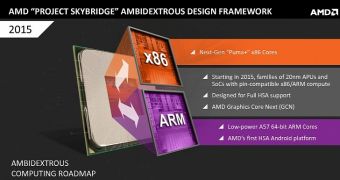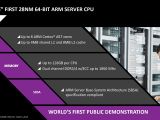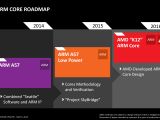Advanced Micro Devices is planning something that may very well turn the processor industry on its head, namely a way to allow ARM and x86 processors to work in the same socket, on the same motherboards.
Not at the same time, mind you, since the frequency of dual-socket motherboards isn't likely to rise, since they're not all that necessary.
No, what AMD is planning is to release a generation of ARM and x86 processing units that are pin-compatible.
Which is to say, you would be able to purchase a motherboard and an ARM CPU/SoC for it, and replace it later with an x86 APU/CPU, or vice-versa.
The Sunnyvale, California-based company calls this concept project SkyBridge and hopes to have some physical proof of its viability in 2015, next year.
The SkyBridge design framework will use 64-bit ARM Cortex A57 cores. It will be the first AMD Heterogeneous System Architecture (HSA) platform for Android.
The x86 chips will be accelerated/central processing units featuring “PUMA+” cores, a more advanced version of the ones used in the recently announced Beema and Mullins mainstream/low-power APU.
A dedicated Platform Security Processor (PSP) will provide the 2015-bound SoCs with AMD Graphics Core Next technology, HSA, and AMD Secure Technology.
Advanced Micro Devices has been toeing both sides of the line separating x86 and ARM chips for quite a while now.
It managed to merge the two architectures, somewhat, in the Beema and Mullins, where the AMD TrustZone technology uses an ARM core to ensure security (by dividing the APU into a normal and a secure zone).
Maybe at some point in the future, the products from AMD will be somewhat akin to NVIDIA's Tegra 4-PLUS-1 chips.
Tegra 4-PLUS-1 use four ARM cores, plus a fifth one that takes over and does everything when nothing strenuous is going on on a tablet. It's great for energy efficiency.
Given AMD's liking of both x86 and ARM technologies, we may eventually see multi-core APUs/SoCs with a low-power ARM core, or core module, whose role would be similar: to perform basic computer tasks (document viewing, web browsing, etc.), while the x86 cores are turned off. It would be a step above any dynamic overclocking technology of today.
That's a long time in the future though, if it will even happen. In the meantime, AMD is setting up the K12 high-performance, low-power ARM-based core.
Scheduled for 2016 release, the K12 hasn't really been elaborated upon. It should be quite a bit better than the Seattle though, the 64-bit ARM-based Opteron A-Series chip that was demoed running Fedora Linux the other day.
Advanced Micro Devices calls this new R&D and production plan the “Ambidextrous Roadmap” because of the implied ability to juggle both markets at the same time. We'll have to wait and see how it all goes.

 14 DAY TRIAL //
14 DAY TRIAL // 



